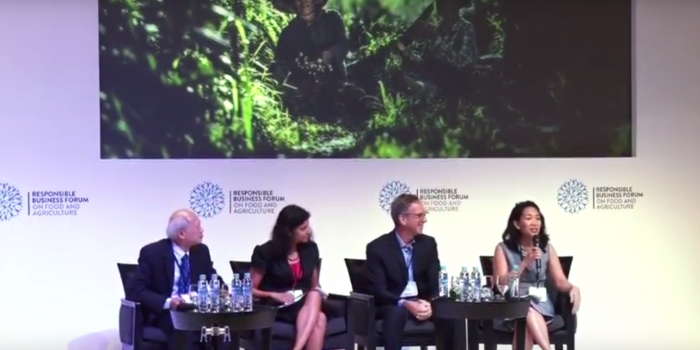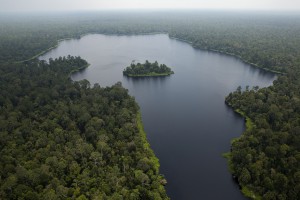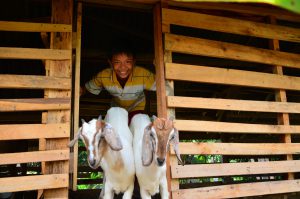Tanoto Forestry Information Centre Celebrates 1st Anniversary
The Indonesian archipelago of some 17,000 islands is home to some of the largest forests in the world. According to the Forestry Statistics of Indonesia published by the Ministry of...

Latest updates on what's happening in RGE Group

APRIL Group contributed a chapter to the Policy White Paper “Efficient agriculture, stronger economies in ASEAN: Private sector perspectives for policy-makers“. The chapter was briefly discussed at last month’s Responsible Business Forum for Food and Agriculture 2016 in Jakarta. Please view the article below. Please also read APRIL Dialog for Director for Sustainability & External Affairs Lucita Jasmin’s comments at the Forum.
In this chapter, we will discuss the following:
Home to about 20 per cent of global plant, animal and marine species, Southeast Asia is one of the world’s most important biodiverse regions. However, according to 2009 studies by the United Nations Environment Programme (UNEP) and the UN’s Food and Agriculture Organisation (FAO), the region is losing approximately 1.2 per cent of its remaining forest annually with Cambodia, Indonesia and the Philippines each reporting annual losses of two per cent between 2004 and 2009.
The same studies note that the conversion of forest for agriculture and cash crop plantations, including the recent expansion in the area devoted to oil palm, continues to be one of the main causes of land use conversion in the region. Alongside unsustainable logging, other deforestation drivers include use of fire for land clearing (Indonesia, Thailand); mining (Indonesia, Laos); urbanisation (Myanmar); hydropower construction (Mekong Basin); road construction (Laos, Cambodia); wood fuel collection (Myanmar, Thailand, Vietnam); migration of ethnic groups (e.g. Myanmar); and community resettlement (Laos).
Concern is growing about increases in greenhouse gas (GHG) emissions due to the rate of deforestation and forest degradation in the ASEAN region. Of particular concern are peatland forests where peat deposits can be up to 20 metres deep and contain vast reserves of near-surface terrestrial organic carbon. Of the 27 million hectares of peatland in Southeast Asia, some 12 million hectares have been deforested or degraded over the past ten years, according to UNEP and FAO estimates.
Deforestation is also influenced by changes in the monsoon cycle. The drought brought on by the El Niño in 1992-1993 led to uncontrolled fires that ravaged more than 27,000 square kilometres. Similar conditions in 1998 served as the catalyst for thousands of forest fires across Malaysia and the Indonesian Archipelago.
Amid these trends, Indonesia reported a significant drop in net forest loss between 2000 and 2005. Although the rate has increased again in the past five years, it is still less than half that experienced during and after the peak period for deforestation that coincided with the large-scale government-backed transmigration programme of people from province to province in the 1980s and early 1990s.
According to the World Resources Institute’s 2016 ‘Forests and Landscapes in Indonesia’ study, around 50 to 60 million Indonesians highly depend on forests to support their livelihoods, while smallholders and industrial forestry, including pulp and paper production, are estimated to contribute around 3.5per cent of Indonesia’s Gross Domestic Product. Overall, the conversion of forested areas and carbon rich peatlands caused Indonesia to become the world’s 6th largest GHG emitter.
Forest fires have long been identified as a major contributor of deforestation in Indonesia. Fires occur on both mineral soil and peatlands across Sumatra and Kalimantan. Slash-and-burn methods to clear land are the main cause of fires and according to 2013 research, approximately 60 per cent of the fires occur on unmanaged land. However, once fires start, they can easily spread into pulpwood and palm oil concession areas.
In 2015, Indonesia faced one of its worst forest fire episodes, with an estimated 2.1 million hectares of land burnt. The fires spread quickly to other areas due to the El Niño conditions that caused extremely dry weather. The transboundary haze that spread across the Southeast Asian region led to carbon dioxide (CO2) emissions in September 2015 that the World Resources Institute reported as having exceeded the average US daily output on 26 out of 44 days.
According to the Government of Indonesia, the 2015 fires and transboundary haze affected the health of more than 43 million people in Indonesia, Malaysia, Singapore, the Philippines, and south Thailand. An estimated 500,000 people were reported to have suffered respiratory infections and 19 people died due to haze-related illnesses. Many schools were closed and flights were cancelled. Thousands of hectares of wildlife habitat were destroyed, with Wetlands International estimating economic losses to be around USD 15 to 30 billion.
Acknowledging the adverse impact of deforestation and forest fires, the Government of Indonesia voluntarily committed to a GHG emissions reduction target of 26 per cent by 2020 while implementing a moratorium on the clearing of primary forests and forested peatlands. The moratorium was first introduced in 2011 and has been extended by President Jokowi Widodo to 2017. The President also announced the establishment of a National Peatlands Restoration Body in January 2016 to advance the conservation and restoration of peatlands across Indonesia.
According to Wetlands International research, there are 13 million hectares of degraded peatlands in Indonesia, concentrated in Sumatra and Kalimantan. This area produces 2,000 million tonnes of CO2 emissions per year, contributing to the largest share of global emissions from degraded peatlands and poses a challenge to the achievement of Indonesia’s climate goals.
Preventing forest fires is crucial to stopping the annual transboundary haze and curbing climate change. Companies in the forestry sector can make a significant contribution to this goal by implementing conservation and restoration programmes on degraded peatlands and forest areas used for agricultural purposes.
 A landscape approach is a holistic approach to sustainable development that integrates the various development imperatives in the landscape. It emphasises managing land use in a holistic way by considering environmental conservation, the livelihood of local communities, biodiversity protection and climate change mitigation. From a company perspective, it aims to achieve a healthy natural infrastructure that creates a balance where plantations receive the ecosystem services they need including water, productive soil and overall biodiversity, while also ensuring primary forests are conserved and protected, and communities have livelihood and quality of life gains.
A landscape approach is a holistic approach to sustainable development that integrates the various development imperatives in the landscape. It emphasises managing land use in a holistic way by considering environmental conservation, the livelihood of local communities, biodiversity protection and climate change mitigation. From a company perspective, it aims to achieve a healthy natural infrastructure that creates a balance where plantations receive the ecosystem services they need including water, productive soil and overall biodiversity, while also ensuring primary forests are conserved and protected, and communities have livelihood and quality of life gains.
This is a model that many sustainability-focused agriculture and forestry companies are working to in order to achieve a balance between production and protection. It is an approach that is necessary to address the issue of continuing degradation of unmanaged land in Indonesia. Unmanaged land is vulnerable to degradation, poor agricultural practices and illegal logging driven by economic pressures in a country where 30 million people live below the poverty line. The goal is to ensure land is managed so that it can be protected and conserved or developed responsibly as part of a holistic, sustainable development framework.
Of the total forest area of 130 million hectares identified by the Indonesian Government, 74 million hectares have been allocated to production forestry while the balance of 56 million has been slated for conservation. Approximately 10 million hectares have been set aside for commercial plantation.
Advocates believe that a landscape approach is essential to the future protection of unmanaged lands. This requires collaboration and constructive engagement between communities, government, NGOs and business with a full understanding of the challenges and opportunities on the ground and respect for each other’s needs and interests.
Asia Pacific Resources International Limited (APRIL Group) is a paper and pulp company that has plantations and production mills in Pangkalan Kerinci, a small township in Riau Province. The company implements a landscape approach to sustainable forestry management that balances production forests with the other pillars of its operations: social empowerment, conservation and restoration, water management on peatlands, and fire prevention.
APRIL Group conserves and protects 400,000 hectares of forest. Some 250,000 hectares have been set aside following High Conservation Value Forest (HCVF) assessments within its concessions, and a further 150,000 hectares are being restored as part of the Riau Ecosystem Restoration (RER) project. APRIL Group has voluntarily committed to conserve one hectare of forest for every hectare of plantation, also known as its 1-for-1 commitment. Currently, APRIL Group is 83 per cent towards achieving this target.
The company’s experience over 20 years of operation in Indonesia has demonstrated that unprotected forested areas are prone to deforestation and degradation by human encroachment, burning and illegal logging if they are not actively managed and monitored. To project HCVF areas, ring plantations of Acacia trees are established around conservation forests, acting as a protective buffer against illegal encroachment, fire and illegal drainage.
The RER project is a multi-year project to restore 150,000 hectares of degraded forests on the Kampar Peninsula, Riau Province. APRIL Group commits financial, technical and operational resources to the project, working in partnership with Fauna & Flora International, The Nature Conservancy and BIDARA, a local non-governmental organisation. Local communities are also involved in the RER project.
In Riau Province, rainfall varies between 55mm per month to more than 500mm during the wettest months. To ensure peatlands remain wet, APRIL Group has installed a water management system to maintain water levels in its concessions season-round. Using a system of water control structures, water level is kept within a prescribed range, depending on the weather season, topography and land use (i.e. plantations, conservation, restoration). This approach has been informed by science-based consultations and industry best practice.
Preventing fires is more effective as a long-term solution than putting them out. In July 2015, APRIL Group launched the Fire Free Village Programme (FFVP) – a comprehensive fire prevention programme that aims to address the root causes of fire through close engagement at the village level. APRIL Group manages the FFVP with two local NGOs, Rumah Pohon and Blue Green, with support from the local governments, police, military and Riau’s Disaster Mitigation Agency.
In 2015, APRIL Group launched a pilot programme in nine villages located inside its concession area. The FFVP combines education and training with infrastructure incentives for local communities to remain fire-free. It also provides fire-fighting equipment for villages and trains villagers on fire suppression capabilities. In the incentive scheme, villages that remain fire-free receive an IDR 100 million grant from APRIL Group to finance village infrastructure projects.
The success of the programme can be measured by the reduction in burnt area. Prior to the FFVP pilot, 750 hectares of forest was burnt in 2013. In 2015, the burnt areas were reduced to only 50 hectares, or by more than 90 per cent in two years. Additionally, there were few fires on peatlands areas. APRIL Group will increase the reach of the project from 2016 onwards, recruiting more villages to participate in FFVP and a complementary Fire Awareness Community programme.
The success of the FFVP has been attributed to intensive community engagement and villager’s taking ownership of the programme. In implementing the FFVP, APRIL Group acted as a facilitator rather than a decision maker. The villagers were enabled to define the most appropriate course of action to achieve a fire-free outcome, giving them a strong sense of empowerment and autonomy.
Alternative Sources of Livelihood
 APRIL Group acknowledges that encroachment, illegal logging, and land burning will persist if local communities are not presented with viable livelihood alternatives and support to implement them.
APRIL Group acknowledges that encroachment, illegal logging, and land burning will persist if local communities are not presented with viable livelihood alternatives and support to implement them.
As an integral part of its landscape approach, the company promotes the social and economic wellbeing of the local communities where it operates through a variety of initiatives. For example, the company assists with the creation of various sources of income for community members and offers training and materials to support their livelihood through community development programmes.
An Integrated Farming System provides training on best practices for community farmers as well as facilitation and technical support. The Community Fiber Farm Programme fosters partnerships with small landowners to help establish their own Acacia plantations.
Complementing this, a small-to-medium sized business enterprises programme works to provide aspiring entrepreneurs with technical and financial expertise.
The Fire Free Alliance (FFA) is an example of a multi-stakeholder collaboration focused on fire prevention through community engagement. Launched on 1 March 2016, the FFA comprises primarily forestry and agriculture companies with the aim of eliminating fire haze in Indonesia. Members of the FFA have committed to adopting the FFVP model while making necessary adaptations to the programme according to the context of the local communities and landscape in which they operate. Members also commit to share knowledge, best practices and resources. The FFA is guided by a panel comprising senior management representatives from each member and supported by a secretariat.
As well as corporate members, the FFA engages NGOs and other relevant stakeholders to actively participate. NGOs will help the FFA to engage local communities, provide general advocacy work at the grassroots level, and provide research support.
As well as participating in the FFA, there are other ways for stakeholders involved in agriculture and forestry to contribute to efforts to prevent forest fires. Private companies can provide financial and technical assistance to villages that are prone to fires, while fulfilling the fundamental responsibilities of implementing sustainable land management practices across their supply chain.
NGOs have an important role to play in educating local communities on the negative long-term impact of destroying and burning forests, particularly on community livelihoods and health. NGOs can also collaborate with private companies on educating local communities on alternatives to fire as a way of clearing land. For local communities, working closely with local governments and private companies operating around their areas provides access to skills, financial and technical assistance.
Annual forest fires cause transboundary haze and huge losses to the economy, environment, and the health and wellbeing of communities in Indonesia and across Southeast Asia.
The landscape approach to sustainable forestry management works to reduce the number of forest fires in Riau Province by balancing production with protection through close community collaboration and a focus on a long-term, balanced outcome.
There is the potential to adopt a landscape approach on a national basis in Indonesia and more widely across ASEAN countries. This will require concerted collaboration between the public and private sector, as well as a long-term vision for community empowerment.
Such collaboration might consider the following factors in striving to produce positive outcomes in Sumatra:
The progress of APRIL Group’s Fire Free Village Programme and its RER project highlight the opportunity for governments to continue to develop enabling regulatory frameworks that encourage more public-private sector conservation and restoration initiatives.
In the same vein, the formulation of its sustainable development policies can benefit from engaging companies, NGOs and communities constructively with a full appreciation of the day-to-day realities in rural communities – a concept that is central to the idea of a landscape approach.